Read My Lips
Cannon Fodder
Theory and Setup
Results
Conclusions
More articles
Discuss this article at

The Ammo
Out of the dizzying array of .45 ACP ammunition offered for sale, I selected what I hoped would provide a representative subset of the types of ammo one could expect to feed an unwitting 1911. There were multiple kinds of hollowpoints, lead semi-wadcutters, short jacketed wadcutters, truncated cones, and even two different kinds of ball ammo just in case it made any difference. (Sneak preview: It didn't.)
The purpose of all this variety was not merely exhaustively thorough overkill (although I do love overkill so very much); rather, I was interested in establishing the sensitivity of the 1911 design in general to minor variations in ogive, meplat, and cartridge length given various magazines' feed lip designs. In other words, it's possible to say that a few hundredths of an inch in length or a tiny taper shouldn't make any difference, but it's very hard to say for sure without trying a variety of bullet shapes.
So let's try a variety of bullet shapes.
Speer Gold Dot
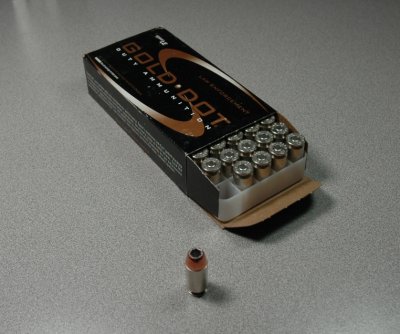
230-grain Speer Gold Dot
First up is one of the most popular hollowpoint brands on the market, Speer's Gold Dots; no ammo test would be complete without them. In .45 ACP, these have a slightly rounded ogive and wide, flat mouth. I'd actually never fired Gold Dots in .45 ACP, so these rounds represented an unknown.
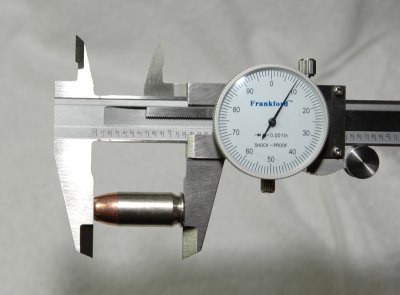
1.209 inches OAL
Gold Dots were one of the shorter hollowpoints tested.
Federal HST
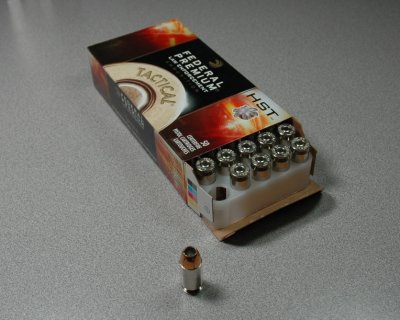
230-grain Federal HST
Federal's HST is their law enforcement-targeted successor to the venerable Hydra-Shok round. Since I could not dig up any of the old-style Hydra-Shoks by the time of the test, this would have to be the next best thing. HSTs have been producing dramatic results in ballistic gelatin, so would their performance feeding into a 1911's chamber be equally good?
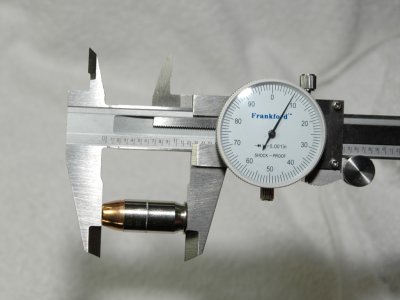
1.208 inches OAL
HSTs are the shortest hollowpoints tested, at a mere 1.208 inches.
Winchester Ranger
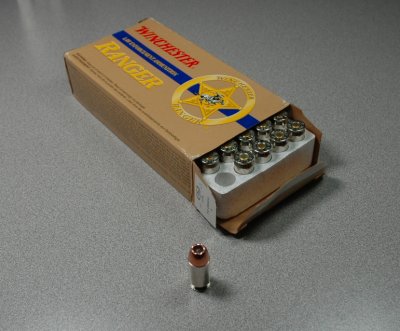
230-grain Winchester Ranger
Winchester Rangers are a popular hot-loaded hollowpoint whose razor-sharp petals inflict horrendous gashes on ballistic gel. I had fired these through my Mil-Spec with good reliability before and found their recoil brisk but controllable. With their scalloped edges, relatively long overall length for a hollowpoint, and curved profile, they raised the possibility of interesting feeding behavior when tested.

1.2145 inches OAL (last digit esimated)
Winchester Rangers are slightly longer than the sub-2.10-inch realm occupied by Gold Dots and HSTs, but are not nearly as long as Golden Sabers or ball ammo. (See below.)
Remington Golden Saber

230-grain Remington Golden Saber
It was with no small amount of self-interest that I selected Golden Sabers as one of the hollowpoints for the test. Golden Sabers happen to be my current 1911 carry ammo, which also makes it easy to dig up a box for testing. I'd always assumed that the relatively long overall length and rounded, ball-like profile meant these rounds enjoyed higher reliability than other hollowpoints, but had never been given the opportunity to test them against others to learn whether my assumptions were correct. Now was the perfect opportunity to do so.
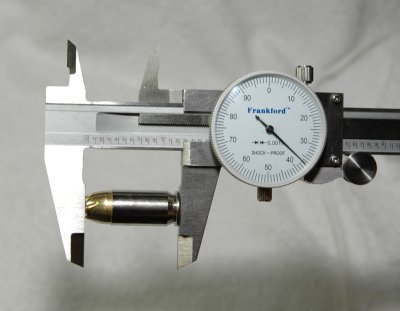
1.2368 inches OAL (last digit estimated)
Golden Sabers are the longest of all the hollowpoints tested by a fair margin.
PMC Ball
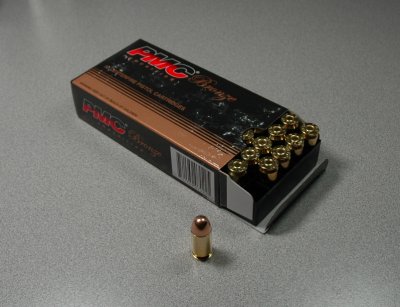
PMC Bronze Line 230-grain full metal jacket
No 1911 ammunition and magazine analysis would be complete without good old ball ammo. 230 grains' worth of copper-clad round-nosed lead is a 1911 staple whose reliability few impugn. At the very least, it would provide a baseline against which to compare the behavior of various hollowpoints and exotically-shaped bullets. Hopefully, its long overall length would illuminate any differences in the way magazine lips fed.
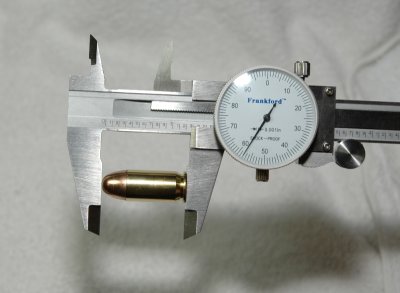
1.258 inches OAL
Much longer than any of hollowpoint; would it matter?
Winchester USA Ball
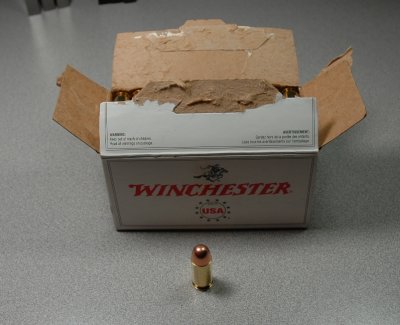
Winchester "White Box" 230-grain ball ammo
Just to be thorough, I grabbed a second brand of full metal jacket. Commonly known as Winchester "White Box" (or WWB), Winchester's USA brand is a budget line commonly sold in 100-round value packs at Wal*Mart. It's an old favorite of mine that has always performed well. It got included in the testing because the shape of the bullet was visually different from the PMC ball ammo, so testing the two side-by-side could possibly reveal subtle differences. It was worth a shot, anyway.

1.266 inches OAL
Winchester's ball ammo is distinctly longer than PMC's, and the longest cartridge tested.
Black Hills Lead Semi-Wadcutter
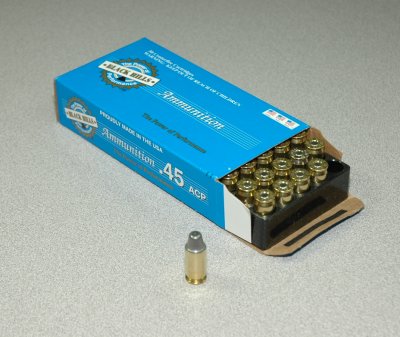
200-grain lead semi-wadcutters
200-grain lead semi-wadcutter rounds have a long history in 1911s. They're lighter-recoiling than hardball rounds and punch clean holes in paper, making them popular with target shooters. However, the sharp shoulders and flat meplat produce a bullet radically different in shape than the round-nose ball ammo for which the 1911 was ostensibly designed. I was interested in finding out if this made any difference in feeding, and if these changes would illustrate the reasoning behind "wadcutter" style feed lips.

1.2497 inches OAL (last digit estimated)
In length, at least, the lead semi-wadcutter rounds had more in common with full metal jacket than hollowpoints.
Hornady Full Metal Jacket Flat Point
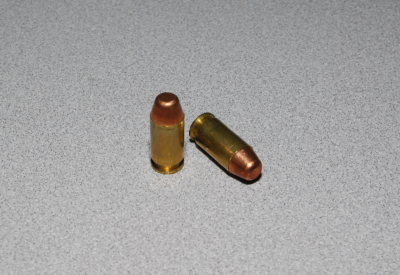
230-grain Hornady FMJ with a flat meplat
The last two candidates for testing aren't factory cartridges, per se, but component bullets with interesting shapes that I loaded into empty cases for testing purposes.
The first of these is Hornady's Full Metal Jacket Flat Point bullet, loaded to the length specified in Hornady's "Handbook of Cartridge Reloading: Seventh Edition". This bullet is interesting because it's a full metal jacket with a truncated cone profile. Early hollowpoints used truncated cone shapes, but these were abandonded in favor of rounded ogives more closely mimicking the ball profile. Was this because truncated cones were unreliable or fed strangely? My curiosity was great enough to justify loading up some test rounds to find out.
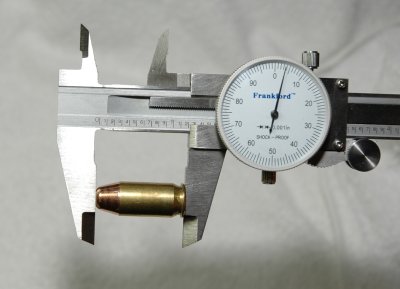
1.2038 inches OAL (last digit estimated)
At only 1.2038 inches, the flat point cartridge was shorter than any of the actual hollowpoints.
Hornady Full Metal Jacket Semi-Wadcutter
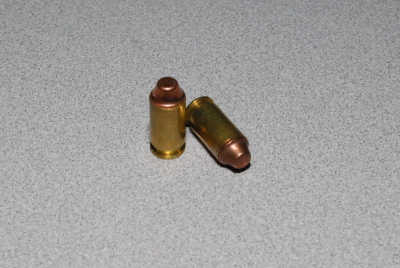
185-grain FMJ semi-wadcutters
This was another unique bullet that I loaded up according to the Hornady Manual's specifications. I bought a bag of these strange-looking little 185-grain bullets in the interests of making a light target load. They showed subpar reliability out of wadcutter mags in my Mil-Spec, so I set them aside. This test provided a great opportunity to dig the box out of my spider-infested garage, reconstitute some dummy rounds, and figure out why exactly they hadn't fed well. With a bullet this short and uniquely shaped, the results were sure to be interesting.
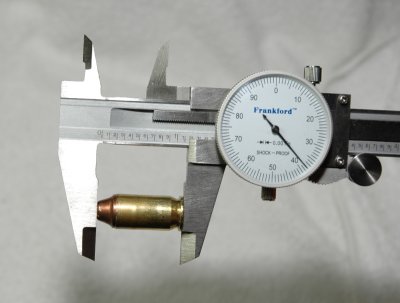
1.138 inches OAL
The shortest of all the tested rounds measured a positively squatty 1.38 inches in overall length.
Summary Table
The following table summarizes the types of ammunition tested:
| Manufacturer | Bullet | Type | Weight (gr.) | Length (in.) |
|---|---|---|---|---|
| Speer | Gold Dot | hollowpoint | 230 | 1.209 |
| Federal | HST | hollowpoint | 230 | 1.208 |
| Winchester | Ranger | hollowpoint | 230 | 1.2145 |
| Remington | Golden Saber | hollowpoint | 230 | 1.2368 |
| PMC | full metal jacket, round nose | ball | 230 | 1.258 |
| Winchester | full metal jacket, round nose | ball | 230 | 1.2668 |
| Black Hills | lead semi-wadcutter | wadcutter | 200 | 1.2497 |
| Hornady | full metal jacket flat point | ball | 230 | 1.2038 |
| Hornady | full metal jacket semi-wadcutter | wadcutter | 185 | 1.138 |
With mags and ammo in hand, all that was required before testing could commence was to determine a methodology.
email: hidi.projects at gmail.com